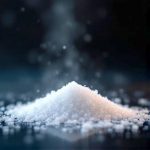Takeaways
- Sodium helps regulate fluid balance in the body
- High sodium intake can lead to water retention
- Sodium affects metabolism and fat storage
- Balanced sodium intake supports healthy weight management
- Individual sodium needs vary based on factors like activity level
- Reading food labels helps monitor sodium consumption
Sodium Basics
Sodium is a vital mineral for human health. It helps regulate fluid balance and supports nerve function. Many foods contain sodium naturally, and it is often added during processing or cooking.
Table salt is a major source of sodium, containing roughly 40% sodium. Common foods high in sodium include:
- Processed meats
- Canned soups
- Savory snacks
- Cheese
- Bread
On average, Americans consume approximately 3,400 mg of sodium each day.[1] This daily intake typically exceeds the recommended levels for most individuals.
Sodium has several important functions in the body, including:
- Maintains fluid balance
- Helps nerve signals travel
- Supports muscle contractions
- Regulates blood pressure
While essential, excessive sodium can be detrimental to health. Maintaining a proper balance is crucial for overall well-being and managing your weight.
Sodium and Water Retention
Sodium influences how much water your body retains. Consuming salty foods causes your body to hold onto more water to maintain a proper sodium concentration in your blood.
This extra water may appear as increased weight.[2] The water weight is usually temporary and goes away after your body processes the excess sodium.
Several factors can affect how sodium influences water retention, including:
- Overall diet
- Hydration status
- Genetics
- Health conditions
- Hormones
Some individuals are more ‘sodium sensitive’ than others. Their bodies react more strongly to changes in sodium consumption.
Water retention due to high sodium intake can lead to:
- Bloating
- Puffiness
- Swollen ankles
- Tight rings or clothes
These effects typically resolve within a few days of lowering sodium intake.[3] Increased water consumption can help the body flush out excess sodium more quickly.
Sodium’s Effect on Metabolism
Sodium plays a role in cellular metabolism by helping transport nutrients, such as glucose, across cell membranes. This process influences how your body utilizes energy.
Research indicates that sodium affects metabolic rate. One study observed a 25% increase in energy expenditure with high salt intake.[4]
Here is a comparison of how sodium impacts different metabolic processes:
| Process | Effect of High Sodium |
|---|---|
| Resting metabolic rate | Increases |
| Thermic effect of food | Increases slightly |
| Exercise metabolism | Can enhance endurance |
While sodium might slightly boost metabolism, this effect is minor. It is not sufficient to counteract the negative impacts of consuming too much sodium.
Some researchers believe that high-sodium diets might increase the activity of brown fat, which burns calories to produce heat. Further research is necessary to confirm this connection.
Overall, sodium’s effect on metabolism is intricate, involving various interconnected body systems. The effects can vary based on individual factors and overall dietary habits.
Sodium and Fat Storage
The relationship between sodium and fat storage is not straightforward. Some studies suggest that high sodium consumption may influence how the body stores and breaks down fat.
Animal studies suggest that a high-salt diet may lead to an increase in fat cell production.[5] This could potentially result in more fat storage over time.
Sodium might also affect hormones involved in fat regulation:
- Insulin: High sodium may worsen insulin resistance
- Leptin: Excess sodium could interfere with this appetite-regulating hormone
- Cortisol: Sodium imbalance may increase stress hormone levels
These hormonal changes could indirectly affect weight by influencing appetite and metabolism. However, studies on humans have shown inconsistent results.
Some researchers propose that sodium might influence where the body stores fat. High sodium intake could potentially promote visceral fat storage around organs.[6] This type of fat has links to increased health risks.
It’s important to remember that sodium’s effects on fat storage are likely small. The overall calorie balance is still the primary factor in fat gain or loss.
Optimal Sodium Intake for Weight Management
Consuming the right amount of sodium can support healthy weight management. The ideal amount varies based on individual needs.
General health guidelines recommend:
- 2,300 mg per day for most adults
- 1,500 mg per day for those with high blood pressure
These limits are designed to balance the benefits of sodium with its potential risks. They aren’t specific to weight management goals.
For weight loss, some experts suggest keeping daily sodium intake under 2,000 mg.[7] This lower intake might help reduce water retention and bloating.
Athletes and very active individuals may require more sodium because heavy sweating increases sodium loss. Replenishing this lost sodium is essential for hydration and optimal performance.
Here is a table showing the sodium content of some common foods:
| Food | Serving Size | Sodium (mg) |
|---|---|---|
| Table salt | 1 tsp | 2,325 |
| Canned soup | 1 cup | 700-900 |
| Deli turkey | 2 oz | 450-600 |
| Bread | 1 slice | 100-200 |
| Fresh vegetables | 1 cup | 10-70 |
Reading food labels helps you monitor your sodium intake. Be aware that lower-fat foods often have more sodium to enhance their flavor.
When managing your weight, consider sodium intake as part of your overall dietary pattern. Emphasize whole, unprocessed foods to naturally moderate sodium consumption.
Low-Sodium Diets and Weight Loss
Low-sodium diets often result in quick initial weight loss. This early decrease is primarily due to water loss.[8]
Reducing sodium intake causes the body to release excess fluid, potentially resulting in:
- 2-3 pounds of water weight loss in the first week
- Less bloating and puffiness
- Looser-fitting clothes
While this initial weight loss can be encouraging, it does not reflect fat loss. Achieving true fat loss requires a calorie deficit over time.
Some benefits of lower sodium intake for weight management include:
- Reduced water retention
- Better hydration (less thirst from salty foods)
- Improved blood pressure
- Potential decrease in cravings for salty, high-calorie foods
To reduce sodium in your diet:
- Cook more meals at home
- Use herbs and spices instead of salt
- Choose fresh foods over processed ones
- Rinse canned vegetables and beans
- Read labels to compare sodium content
Be aware that very low sodium diets can have drawbacks. Sodium is still an important nutrient. Extreme restriction could cause:
- Headaches
- Fatigue
- Muscle cramps
- Increased heart rate
Most people don’t need to eliminate sodium completely. A moderate reduction often provides benefits without unwanted side effects.
High-Sodium Diets and Weight Gain
High-sodium diets have links to weight gain over time.[11] This connection likely involves several contributing factors.
Excessive sodium intake can result in:
- Increased water retention
- Higher blood pressure
- Potential hormonal changes
These effects may indirectly promote weight gain. High-sodium foods are often calorie-dense, making overeating more likely.
Studies show a link between sodium intake and the risk of obesity.[9] One large study found that each additional gram of salt consumed daily increased obesity risk by 26%.[10]
Sodium might affect appetite and food preferences. Research suggests that high salt consumption can:
- Increase hunger and thirst
- Enhance the taste of fatty foods
- Stimulate cravings for salty snacks
These effects could result in consuming more calories overall. Over time, this might lead to weight gain.
Some researchers suggest that sodium could affect the gut microbiome. Changes in gut bacteria might influence weight. Further research is needed to confirm this idea.
While sodium itself doesn’t cause weight gain, high intake often goes along with less healthy eating habits. Focusing on whole foods naturally moderates sodium and supports weight management.
Sodium Balance and Hydration
Proper sodium balance is crucial for hydration. Your body maintains constant sodium levels in your blood by adjusting the amount of water it retains.
When sodium intake is high, you retain more water. This can lead to:
- Feeling bloated
- Increased thirst
- Higher blood pressure
Low sodium levels have the opposite effect. You may lose too much water, which can lead to dehydration.
Balancing sodium and water intake supports healthy weight management. Here’s why:
- Proper hydration boosts metabolism
- Water can help you feel full
- Staying hydrated prevents mistaking thirst for hunger
- Adequate fluids support exercise performance
To maintain a healthy sodium-water balance:
- Drink water regularly throughout the day
- Eat plenty of fruits and vegetables
- Limit processed foods high in sodium
- Replace fluids lost through sweat
- Monitor urine color (pale yellow is ideal)
Remember that individual needs vary. Factors like climate, activity level, and health conditions affect your sodium and fluid requirements.
Sodium and water intake work together. Paying attention to both supports overall health and facilitates weight management.
Sodium’s Impact on Exercise Performance
Sodium is vital for exercise performance. It helps maintain fluid balance during physical activity, particularly for endurance sports.
During exercise, you lose sodium through sweat. The amount lost varies depending on:
- Exercise intensity
- Duration
- Climate
- Individual factors
Replacing lost sodium supports:
- Proper hydration
- Muscle function
- Nerve signaling
- Temperature regulation
For most short workouts (under one hour), extra sodium is not necessary. Water is usually sufficient. For longer or more intense sessions, sodium replacement is important.
Endurance athletes often use sports drinks or salt tablets to replace both fluids and electrolytes lost through sweat.
Adequate sodium intake before exercise can improve performance. It helps your body retain water, supporting hydration. This may:
- Delay fatigue
- Reduce cramping risk
- Improve endurance
After exercise, replacing lost sodium aids recovery. It helps restore fluid balance and supports muscle repair.
However, excessive sodium intake can be harmful. It may lead to:
- Nausea
- Vomiting
- Increased risk of hyponatremia (low blood sodium)
Hyponatremia, a dangerous condition, can occur when athletes drink too much water without enough sodium.[12] Symptoms may include confusion, seizures, and in severe cases, death.
Most people don’t need to worry about sodium depletion during exercise. A balanced diet typically provides enough for casual workouts. Extra sodium is generally only needed for intense endurance activities.
Sodium Sensitivity and Weight
Sodium sensitivity refers to how strongly blood pressure responds to sodium intake. This trait varies among individuals and can affect weight management.
People with high sodium sensitivity may:
- Retain more water with salt intake
- Have larger blood pressure changes
- Be at higher risk for salt-related health issues
Factors that contribute to sodium sensitivity include:
- Genetics
- Age (sensitivity often increases with age)
- Race (more common in African Americans)
- Existing health conditions
For individuals sensitive to sodium, reducing salt intake can often lead to:
- Significant drops in blood pressure
- More noticeable decreases in water retention
- Potentially easier weight management
Research suggests a link between sodium sensitivity and weight gain.[13] One study found that sodium-sensitive individuals gained more weight over time than non-sensitive people.
The reasons for this link aren’t fully understood. Potential explanations include:
- Greater fluid retention with high sodium intake
- Differences in how the body processes calories
- Potential effects on fat storage hormones
Identifying sodium sensitivity can be useful for weight management. If you suspect you are sensitive, try reducing sodium intake and monitor your body’s response.
Signs of potential sodium sensitivity include:
- Rapid weight changes with salt intake shifts
- Noticeable bloating after high-sodium meals
- Larger than average blood pressure changes with sodium intake
Remember, sodium sensitivity exists on a spectrum. Most people fall somewhere in the middle. Paying attention to your body’s responses can help guide your sodium intake decisions.
Balancing Sodium with Other Electrolytes
Sodium doesn’t work alone in the body. It interacts with other electrolytes, especially potassium. Balancing these minerals supports healthy fluid levels and weight management.
Sodium and potassium have opposing effects on fluid retention:
- Sodium increases water retention
- Potassium promotes water excretion
A proper balance between these electrolytes helps:
- Regulate blood pressure
- Support nerve and muscle function
- Maintain healthy fluid levels
Here is a comparison of sodium’s interactions with different electrolytes:
| Electrolyte | Interaction with Sodium |
|---|---|
| Potassium | Counteracts sodium’s effects on blood pressure |
| Calcium | Works with sodium for nerve signaling |
| Magnesium | Helps regulate sodium levels in cells |
Many people consume too much sodium and not enough potassium. This imbalance may contribute to:
- High blood pressure
- Increased fluid retention
- Potential weight gain over time
To improve your sodium-potassium balance:
- Eat more fruits and vegetables (high in potassium)
- Choose whole grains over refined carbs
- Limit processed foods (often high in sodium, low in potassium)
- Consider using a potassium-based salt substitute
Other electrolytes, such as calcium and magnesium, also play roles in fluid balance. A varied diet typically provides sufficient amounts of these minerals.
Focusing on overall electrolyte balance, rather than just sodium, supports healthy weight management. It promotes proper hydration and helps your body function optimally.
Sodium and Blood Pressure
The connection between sodium and blood pressure impacts weight management. High blood pressure can make weight loss more difficult.
Sodium affects blood pressure by:
- Increasing fluid retention
- Affecting blood vessel function
- Influencing kidney function
For many people, reducing sodium intake lowers blood pressure. This effect is often more pronounced in:
- Older adults
- People with existing high blood pressure
- African Americans
- Those with chronic kidney disease
Current recommendations for sodium intake for individuals with hypertension are:
- No more than 1,500 mg per day
- Further reductions may provide additional benefits
Lowering blood pressure through sodium reduction can:
- Reduce strain on the heart
- Improve kidney function
- Support overall cardiovascular health
These benefits may indirectly support weight management. Healthier cardiovascular function can make exercise easier and more effective.
Some studies suggest a connection between high blood pressure and weight gain. The reasons are not fully understood, but may involve:
- Hormonal changes
- Alterations in metabolism
- Effects on appetite regulation
Managing sodium intake as part of blood pressure control may help create a more favorable environment for weight management.
It’s important to remember that not everyone is equally sensitive to sodium’s effects on blood pressure. Some people can consume more without significant impacts.
If you have high blood pressure, work with your healthcare provider to determine the right sodium intake for you. They may recommend:
- Gradual sodium reduction
- Regular blood pressure monitoring
- Combining sodium reduction with other lifestyle changes
Remember that blood pressure management is just one aspect of overall health. A balanced approach to diet and lifestyle supports both blood pressure control and healthy weight.
Reading Food Labels for Sodium Content
Understanding food labels can help you manage sodium intake. This can support weight management efforts by encouraging informed choices.
When reading food labels, look for:
- Sodium content per serving
- Serving size (often smaller than you’d expect)
- Percent Daily Value (%DV) for sodium
The %DV is based on a 2,300 mg daily sodium limit.[14] Choose foods with a sodium %DV of 5% or less per serving.
Be mindful of these common high-sodium ingredients:
- Salt
- Sodium bicarbonate
- Monosodium glutamate (MSG)
- Sodium nitrite
- Sodium benzoate
Many foods contain hidden sodium sources. Be aware of:
- Condiments and sauces
- Canned vegetables
- Bread and baked goods
- Cheese
- Breakfast cereals
When shopping, compare similar products. The sodium content can vary significantly between brands.
Choose ‘low sodium’ or ‘no salt added’ versions when available, but always check the label. These terms don’t always mean sodium-free.
Remember that whole, unprocessed foods are naturally lower in sodium. Fresh fruits, vegetables, and unsalted nuts are good low-sodium options.
Reading labels takes practice. Over time, it becomes easier to identify high-sodium foods. This can help you make choices that support your weight management goals.
Cooking Methods to Reduce Sodium
Preparing meals at home allows you to control the sodium content. Simple cooking methods can reduce sodium while keeping food flavorful.
Try these low-sodium cooking methods:
- Use herbs and spices instead of salt
- Marinate meats in citrus juices or vinegar
- Roast or grill vegetables to enhance natural flavors
- Make your own salad dressings and sauces
- Rinse canned beans and vegetables
Gradually reduce the amount of added salt in recipes. Your taste buds will adjust over time.
To lower sodium in home-cooked meals:
- Start with fresh, whole ingredients
- Measure salt carefully when cooking
- Taste food before adding salt at the table
- Use salt-free seasonings like Mrs. Dash
- Experiment with acidic flavors like lemon or vinegar
These steps can significantly reduce sodium without compromising taste. Lower-sodium meals can support your weight management efforts.
Reducing sodium in cooking may affect weight management by:
- Decreasing water retention
- Potentially lowering calorie intake (if replacing salty snacks)
- Encouraging more home-cooked meals (often healthier overall)
Remember that small changes can add up. Even modest sodium reductions can benefit your health and weight over time.
Sodium Intake and Long-term Weight Management
Research on sodium’s long-term effects on body weight shows varying results. Some studies suggest a link between higher sodium intake and weight gain over time.
A large study that followed participants for 7 years found that higher sodium intake was associated with an increased risk of obesity.[15] However, other research shows less definitive connections.
Factors that may influence sodium’s long-term impact on weight include:
- Overall diet quality
- Physical activity levels
- Genetics
- Age and sex
- Existing health conditions
Consistent sodium management can support sustainable weight loss and maintenance by:
- Reducing water retention
- Potentially lowering calorie intake from processed foods
- Supporting overall healthy eating habits
Long-term sodium reduction might improve:
- Blood pressure control
- Kidney function
- Cardiovascular health
These benefits can create a foundation for easier weight management. Healthy body systems work together more efficiently.
Some researchers believe that a high sodium intake might increase the risk of metabolic syndrome, a condition that is linked to weight gain and obesity. More research is required to confirm this connection.
For successful long-term weight management, it’s important to focus on:
- Consistent, moderate sodium intake
- Balanced diet rich in whole foods
- Regular physical activity
- Adequate hydration
- Stress management
Remember that sodium is just one factor in the complex process of weight management. A holistic approach will yield the best results over time.
FAQ: People Also Ask
How does sodium cause weight gain?
Can reducing salt intake lead to weight loss?
Is sea salt better for weight loss than table salt?
How much sodium should I eat to lose weight?
Does sodium affect metabolism?
Can too little sodium cause weight gain?
Conclusion
Sodium has a complex role in body weight and overall health. While it does not directly cause fat gain or loss, it influences fluid balance and can affect weight management efforts.
Key points to remember:
- Moderate sodium intake supports healthy fluid balance
- High sodium intake can lead to water retention and bloating
- Reducing sodium often results in quick water weight loss
- Long-term weight management requires a balanced approach to sodium
- Individual needs vary based on factors like activity level and health status
For most people, focusing on whole foods naturally moderates sodium intake. This supports both weight management and overall health.
Remember to:
- Read food labels to track sodium intake
- Cook more meals at home to control sodium levels
- Balance sodium with other electrolytes, especially potassium
- Stay hydrated to support your body’s natural balance
Ultimately, sodium is just one component of weight management. A comprehensive approach that includes a balanced diet, regular physical activity, and stress management leads to the best long-term outcomes.
By understanding sodium’s role in your body, you can make informed decisions to support your weight and health goals. Small, consistent changes in sodium intake can contribute to overall wellness over time.
This figure is a common estimate, however, it is variable depending on several demographics and study methods. The CDC provides similar data.
Source: “Initiatives to Reduce the Content of Sodium in Food Products and Meals and Improve the Population’s Health” https://www.ncbi.nlm.nih.gov/pmc/articles/PMC10222223/
This weight is due to water retention, not an increase in fat mass and is transient.
The body will adjust and release excess water as sodium levels normalize.
The body may expend additional energy in processing sodium, however, this effect is not a reliable way to achieve weight loss. More research is needed on the clinical significance of this effect.
It’s important to note that animal studies do not directly translate to human physiology. More research is needed on humans. These animal studies are cited in the text
Source: “High dietary sodium intake increases white adipose tissue mass and plasma leptin in rats” https://pubmed.ncbi.nlm.nih.gov/17890487/
More research is needed to confirm the extent to which sodium influences fat distribution. Visceral fat is indeed a risk factor for many health issues.
This recommendation is primarily for managing fluid balance rather than directly causing fat loss.
This weight loss is temporary and does not indicate actual fat reduction.
This is an associative observation, it is difficult to show causality
Source: “Replacing salt with low‐sodium salt substitutes (LSSS) for cardiovascular health in adults, children and pregnant women” https://www.ncbi.nlm.nih.gov/pmc/articles/PMC9363242/
This study should be viewed with context, other research does not support this specific correlation. Causality is not necessarily implied.
Source: “Sodium intake may promote weight gain; results of the FANPE study in a representative sample of the adult Spanish population” https://pubmed.ncbi.nlm.nih.gov/24972464/
This is an associative observation. Often high sodium diets are accompanied by other negative health choices.
This is especially dangerous during high intensity endurance events. Sports drinks and/or salt supplements are sometimes used to prevent this condition.
More research is needed to confirm these findings.
This is standard nutrition labeling on food products. This is a reference for general health but specific needs vary.
This is an observational study. More research is needed to confirm or deny causality.
Sodium does affect water retention, but is not directly involved in lipogenesis. This is a common misconception.
This is due to the reduced water retention in the body after reducing sodium intake.
Sea salt may contain trace minerals, but this is inconsequential in the context of weight management.
This recommendation is set by public health authorities for healthy adults.
Sodium is needed for cellular function, but other factors have a much greater impact on metabolism.



